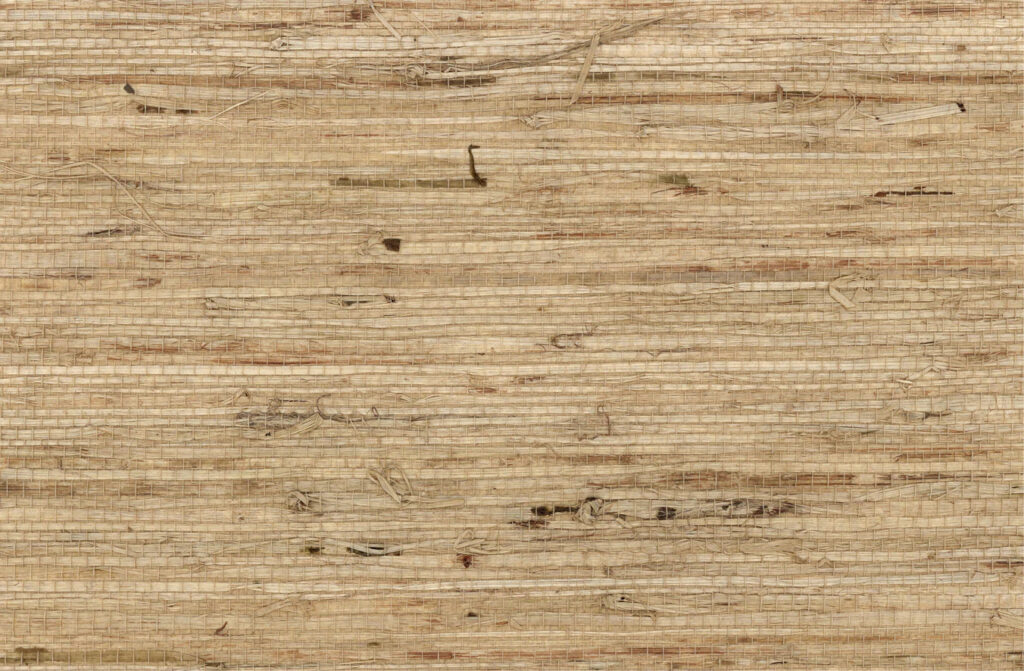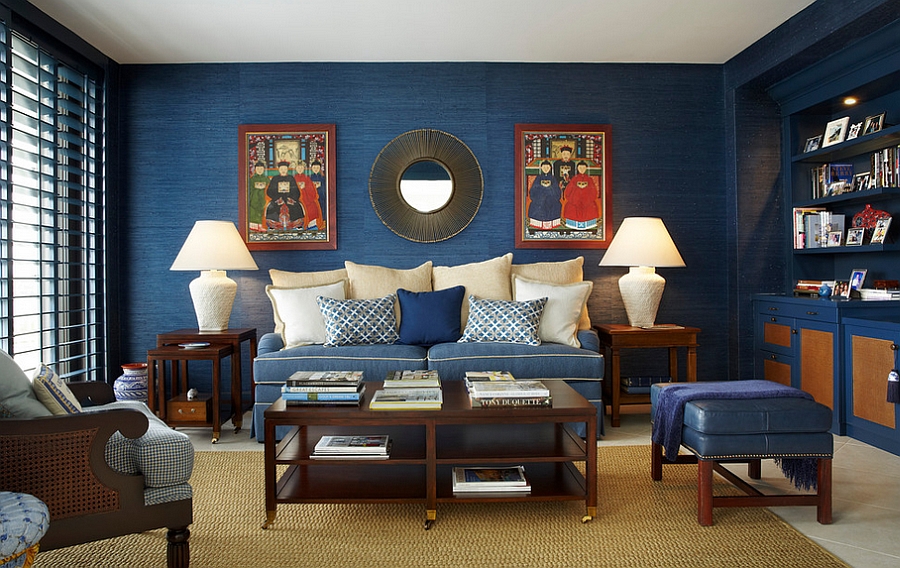As more individuals look for ways to make their homes eco-friendly while maintaining a pleasant indoor environment, grasscloth wallpapers are growing in popularity. Although it may sound like a new concept, the grasscloth has been around for several decades and is one of the most versatile home décor products. Grasscloth wallpaper is distinct from all other organic wall coverings. It is tricky to install, delicate, and expensive, but the end result is worth all the trouble, which is why it is popular in both the residential and hospitality sectors.
This article will discuss the definition of a grasscloth wallpaper, how it is created, its types, and things you should know before buying this wall covering.
What is Grasscloth Wallpaper?

The term “grasscloth” describes wallcoverings produced from hand-woven natural fibre strands on an unpasted rice paper backing. The organic materials used in making grasscloth wallpapers include jute, seagrass, hemp, bamboo, raffia, and arrowroot grass. They are delicate and challenging to install, making them more expensive than ordinary wall coverings.
How is Grasscloth Made?

Most grasscloths are made in Asia and shipped to different parts of the world. The natural fibres are typically made with lightweight cotton threads and fastened to a rice paper backing. Generally, grasscloth comes in a horizontal or vertical pattern, the former being the most popular style.
Grasscloth is packaged differently from standard wallpapers. For example, a double roll of grasscloth wallpaper almost always measures 36 inches in width and 24 feet in length, whereas regular wallpaper measures 27 inches or 21 inches in width.
History of the Grasscloth
Grasscloth wallpapers were developed in ancient China as a cheaper-to-produce alternative to elaborately embroidered silk wall treatments. The grasscloth was cheaper to produce and a good insulator, making it quickly grow in popularity in Asia. This new wallpaper soon reached the shores of Europe through trade and has been a popular product for rustic decor ever since. It continues to be used in modern home decor.
Grasscloths, even today, are made of Asian grasses and plant fibres like bamboo, cat-tail, hemp, raffia etc., in the age-old hand-weaving process.
According to the Journal of the Royal Society of Arts (Vol. 72, 1924), the grasscloth was woven from hemp, ramie, pineapple fibre, or a mixture of them and the bark of hemp. In the journal, the United States Trade Commissioner in Shanghai describes the material, known to the Chinese as “hsaipu” (summer cloth), as “excellent in texture” and worn by both the Chinese and foreigners. He even stated that the best quality grasscloth was “quite expensive” compared to the finest silk and satin. It was a special product of the Fukien, Hunan, Kwangtung, Kiangsi, Kiangsu, and Szechwan provinces.
As per the Trade Commissioner’s accounts, the grasscloth was used to make mosquito nets, cordage, bags, and even mourning clothes.
Types of Grasscloth
Grasscloth can be classified into different types:
Materials Used
Natural Grasscloth

As the name suggests, this grasscloth is made from organic fibres, which fill the space with a natural grassy scent. You can easily tell them apart from faux grasscloth by looking at the width. A good majority of natural grasscloth is 36 inches wide, and anything less than that is most likely a faux-pattern product.
Faux Grasscloth

They are made to imitate natural grasscloths; some come close to the real thing. The more they resemble organic grasscloths in their looks and texture, the more expensive faux grasscloth wallpapers become. This grasscloth is more durable and easier to maintain than its natural counterpart because it is a vinyl wall covering. They are also easy to install, clean, and remove.
Grasses Used
Sisal Grasscloth

Sisal wallpaper is made from the fibres of Mexican agave plants that are closely woven together and dried in the sun. It was used by the Aztecs in their textiles and is popular for its durability and simplicity.
Raw Jute Grasscloth

Like sisal, raw jute grasscloth is also closely woven but is more textured thanks to the thicker fibres. This grasscloth also uses a mix of different coloured fibres to blend the overall colour of the product.
Seagrass Grasscloth

Seagrass wallpaper has a rich texture and natural character. Their bands are thick and have visible loose ends and odds, which add to the aesthetic.
Arrowroot Grasscloth

Arrowroot grasscloth has natural, dark-toned flecks woven with untrimmed strips of fibre. In addition, it has choppy horizontal details that give the wallpaper a subtle, light tropical texture.
Bamboo Grasscloth

Bamboo grasscloth has thick and defined fibres that create a contrasting panelled detail. In addition, bamboo gives the wallpaper rich natural green and ochre colours, which makes them the ideal alternative for wood panelling.
Treatments used in Grasscloth Wallpaper
Metallic Grasscloth Wallpaper

Apart from the texture, the grasscloth with a metallic finish adds shimmer to your walls. The metallic glaze contrasts the original natural finish of the grasscloth and makes your room look more exciting. Metallic grasscloths can be wholly or lightly coated and come in finishes like gold, silver, copper, or bronze. You can achieve these finishes with sisal, jute, and seagrass grasscloth.
Printed Grasscloth Wallpaper

This treatment will give you the printed wallpaper you want with the added benefit of textured, hand-woven detailing. You can get almost any patterned grasscloth wallpaper with floral, leafy, striped, or damask designs.
What is the best place to use Grasscloth?

Grasscloths are primarily installed in dining rooms, living rooms, master bedrooms, libraries, and powder rooms that are not used often. Some people even hang grasscloths in their bathrooms.
Things to Consider Before Buying Grasscloth Wallpaper
01. Grasscloth Wallpapers are Inconsistent
Unlike other mass-produced wallpapers, grasscloth wallpapers are handmade and differ from roll to roll. Even if they are made from the same materials grown in the same plot, there will be colour or value differences. Regular wallpapers are machine-produced; thus, the colours, printing, and other elements are tightly controlled, and therefore these differences don’t exist in them.
02. Unpasted Backing
Prepasted grasscloth wallpaper has yet to be a thing. Instead, you must manually apply speciality wallpaper glue on your walls to stick your grasscloth.
03. Grasscloth Wallpaper Expands When Wet
Grasscloth tends to expand and develop air bubbles along the surface when exposed to condensation from the glue and walls. It is advisable to soak the wallpaper in water before mounting it on your walls.
04. Can not be used in High-Traffic Areas
Grasscloth is light and delicate by its very nature. They are susceptible to damage, especially if you constantly bump into them, carelessly move furniture, have children or pets etc. Grasscloths are much more at risk when cats are around, as they tend to scratch them.
05. Grasscloth Wallpapers are Expensive
Grasscloth is the ultimate luxury wallcovering, as it is the most expensive type of wallpaper. The high cost is because the grasscloth weaving process is labour and time-intensive. Each roll of grasscloth is hand-woven by skilled people.
06. Not suited for Rooms with More Sunlight
The colours of your grasscloth wallpaper will fade if exposed to direct sunlight for extended periods of time. So, you should avoid hanging your expensive grasscloth in rooms that receive a lot of direct sunlight.
07. Visible Seams
The fact that no two rolls of grasscloth are alike means that, once installed, the seams between the rolls will be noticeable. Many feel that this characteristic adds a certain charm and detail to their walls. However, if you feel like the seams will bother you, you can opt for faux grasscloth wallpaper.
08. Intensity of the Natural Scent Reduces
Grasscloth gives off a lovely and subtle natural grassy scent that fills the room. The scent’s intensity gradually reduces but will continue to linger as long as there is grasscloth in the room.
09. Walls Need Priming
Get the most out of your grasscloth by priming your walls before installing the wallpaper. The surface of the walls must be smooth before installation to avoid any lumps getting amplified by the grasscloth. Drywalls also need priming, as it becomes easier to hang and remove your grasscloth. Priming the walls beforehand will also help extend the life of your wallpaper as it prevents the formation of air bubbles while the wallpaper is drying and setting.
10. Professional Installation gives the Best Results
Installing a grasscloth might be challenging if you don’t know what you are doing. It is delicate and expensive to boot. It takes a certain level of skill to hang grasscloths, especially if you need them to bend around corners. It will be very difficult to fix any mistakes if you decide to complete the project on your own and damage, tear or taint the wallpaper in the process. For the finest results, hire wallpaper installation professionals or wallcovering companies experienced in mounting grasscloth.
11. Beware Condensation in Bathrooms
As previously mentioned, the grasscloth is prone to developing air bubbles due to condensation. Grasscloth is very absorbent. This will cause the wallpaper to stain if any liquid falls on it, and its useful life will be reduced. Ensure that your bathroom is properly ventilated and has an exhaust fan to expel the humid air if you really want to have grasscloth on the bathroom walls. Also, hang it up high enough to prevent water, soap, urine, toothpaste, etc. from splashing onto its surface.
12. Not Easy to Repair
Each roll of grasscloth is different from the next, which means that finding a close enough match to repair a torn, stained, or otherwise damaged roll of grasscloth wallpaper is extremely difficult. If anything happens to your grasscloth, you may need to replace entire sections to make the repair work less obvious.
13. Careful Cleaning
You can’t clean the grasscloth like any other wallpaper. The best way to clean this wallcovering is by gently wiping it down or lightly vacuuming it. Be careful not to be abrasive in your cleaning methods. If in doubt, test the best cleaning method on any leftover piece of grasscloth.
Conclusion
Finally, we suggest that you buy grasscloth wallpaper only if you are prepared to deal with the difficulties and costs associated with installation and maintenance. Understand that grasscloth is expensive, delicate, and doesn’t always have an even look. Although some people prefer the inconsistency of this wall covering, be sure you are willing to deal with the visible colour variations and seams. Always do your research before undertaking a home decor project so that you don’t have any regrets when it is too late.
Image Courtesy: Image 2, Image 3, Image 4, Image 5, Image 6, Image 7, Image 8 – tm-interiors.co.uk, Image 9, Image 10, Image 11, Image 12, Image 13
Author Bio
Andrea Noronha – Andrea Noronha is a content writer and editor with over 4 years of experience. Although she comes from a finance background, Andrea is passionate about blogging about interior design. Her other interests include travelling, baking, and digital marketing.


